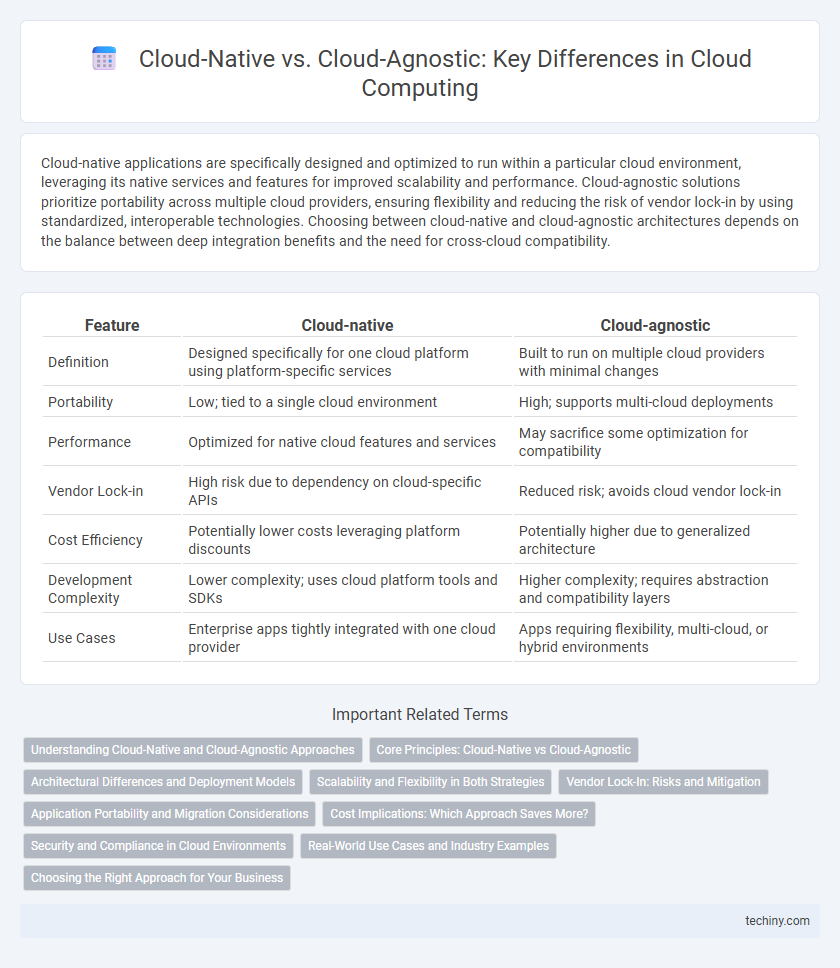Cloud-native applications are specifically designed and optimized to run within a particular cloud environment, leveraging its native services and features for improved scalability and performance. Cloud-agnostic solutions prioritize portability across multiple cloud providers, ensuring flexibility and reducing the risk of vendor lock-in by using standardized, interoperable technologies. Choosing between cloud-native and cloud-agnostic architectures depends on the balance between deep integration benefits and the need for cross-cloud compatibility.
Table of Comparison
| Feature | Cloud-native | Cloud-agnostic |
|---|---|---|
| Definition | Designed specifically for one cloud platform using platform-specific services | Built to run on multiple cloud providers with minimal changes |
| Portability | Low; tied to a single cloud environment | High; supports multi-cloud deployments |
| Performance | Optimized for native cloud features and services | May sacrifice some optimization for compatibility |
| Vendor Lock-in | High risk due to dependency on cloud-specific APIs | Reduced risk; avoids cloud vendor lock-in |
| Cost Efficiency | Potentially lower costs leveraging platform discounts | Potentially higher due to generalized architecture |
| Development Complexity | Lower complexity; uses cloud platform tools and SDKs | Higher complexity; requires abstraction and compatibility layers |
| Use Cases | Enterprise apps tightly integrated with one cloud provider | Apps requiring flexibility, multi-cloud, or hybrid environments |
Understanding Cloud-Native and Cloud-Agnostic Approaches
Cloud-native applications are specifically designed to leverage cloud environments, utilizing microservices, containerization, and continuous integration/continuous deployment (CI/CD) pipelines to optimize scalability and resilience. Cloud-agnostic strategies prioritize portability across multiple cloud providers by avoiding proprietary services, often relying on standardized APIs and infrastructure-as-code tools like Terraform. Understanding these approaches helps organizations balance innovation speed and flexibility in multi-cloud or hybrid cloud architectures.
Core Principles: Cloud-Native vs Cloud-Agnostic
Cloud-native applications leverage microservices architecture, containerization, and dynamic orchestration to optimize scalability, resilience, and continuous delivery within specific cloud environments. Cloud-agnostic designs prioritize portability across multiple cloud platforms by using standardized APIs, infrastructure-as-code, and abstraction layers to avoid vendor lock-in and enable flexible deployment. Understanding these core principles helps organizations balance innovation speed with multi-cloud strategy adaptability.
Architectural Differences and Deployment Models
Cloud-native architectures leverage microservices, containerization, and orchestration tools like Kubernetes to optimize application scalability and resilience within specific cloud environments. Cloud-agnostic designs emphasize portability and flexibility, using abstraction layers and open standards to deploy applications seamlessly across multiple cloud providers. Deployment models for cloud-native solutions often rely on managed platform services, whereas cloud-agnostic approaches utilize infrastructure-as-code and continuous integration pipelines to maintain consistent environments regardless of the underlying cloud platform.
Scalability and Flexibility in Both Strategies
Cloud-native architectures leverage scalable microservices designed to automatically adapt to demand within specific cloud environments, maximizing performance and resource efficiency. Cloud-agnostic strategies prioritize flexibility by enabling applications to run seamlessly across multiple cloud providers, reducing vendor lock-in while maintaining scalability through standardized interfaces. Both approaches enhance scalability and flexibility, but cloud-native solutions optimize for deep integration and rapid scaling within a single ecosystem, whereas cloud-agnostic methods emphasize portability and adaptability across diverse infrastructures.
Vendor Lock-In: Risks and Mitigation
Cloud-native applications are designed specifically for a particular cloud provider's infrastructure, which can lead to vendor lock-in risks due to proprietary services and APIs. Cloud-agnostic strategies focus on using open standards, containerization, and orchestration tools like Kubernetes to mitigate vendor lock-in by ensuring portability across multiple cloud environments. Implementing abstraction layers and avoiding cloud-specific features helps organizations maintain flexibility and control over deployment options.
Application Portability and Migration Considerations
Cloud-native applications are optimized for specific cloud platforms, leveraging platform-specific services and APIs, which can enhance performance but limit portability across different cloud providers. Cloud-agnostic applications avoid reliance on proprietary cloud services, promoting greater flexibility and ease of migration by utilizing standardized technologies such as containers, Kubernetes, and open-source tools. Prioritizing cloud-agnostic design significantly reduces vendor lock-in risks and simplifies workload migration strategies, crucial for enterprises aiming for multi-cloud or hybrid cloud deployment models.
Cost Implications: Which Approach Saves More?
Cloud-native architectures often require initial investment in specialized platforms and vendor-specific services, which can lead to higher upfront costs but optimize long-term operational efficiency through automated scaling and management. Cloud-agnostic solutions avoid vendor lock-in by using portable technologies like containers and Kubernetes, potentially reducing migration expenses and enabling competitive pricing across multiple providers. Cost savings depend on workload variability, with cloud-native excelling in consistent, high-demand scenarios, while cloud-agnostic approaches benefit dynamic or multi-cloud strategies by minimizing platform dependency costs.
Security and Compliance in Cloud Environments
Cloud-native architectures leverage built-in security features and compliance tools specific to their cloud providers, enabling streamlined governance through automated controls and continuous monitoring. Cloud-agnostic strategies demand customized security frameworks and compliance adaptations across multiple platforms, increasing complexity but enhancing flexibility in regulatory adherence. Understanding the trade-offs between provider-specific protections and cross-cloud policy enforcement is critical for robust data security and regulatory compliance.
Real-World Use Cases and Industry Examples
Cloud-native applications leverage platform-specific services such as AWS Lambda and Google Kubernetes Engine to optimize scalability and performance, evident in industries like finance where rapid transaction processing is crucial. Cloud-agnostic solutions prioritize flexibility, enabling companies like Netflix to deploy services seamlessly across multiple cloud providers to avoid vendor lock-in and ensure continuous availability. Real-world adoption highlights cloud-native benefits in innovation speed, while cloud-agnostic strategies emphasize cost management and disaster recovery across diverse cloud environments.
Choosing the Right Approach for Your Business
Cloud-native applications leverage specific cloud provider features to maximize performance, scalability, and cost-efficiency, making them ideal for businesses fully committed to a single cloud ecosystem. Cloud-agnostic strategies prioritize portability and flexibility, enabling organizations to avoid vendor lock-in and easily migrate workloads across multiple cloud platforms. Evaluating business goals, technical requirements, and long-term cloud strategy is essential for choosing the right approach that balances innovation speed with infrastructure adaptability.
Cloud-native vs Cloud-agnostic Infographic

 techiny.com
techiny.com